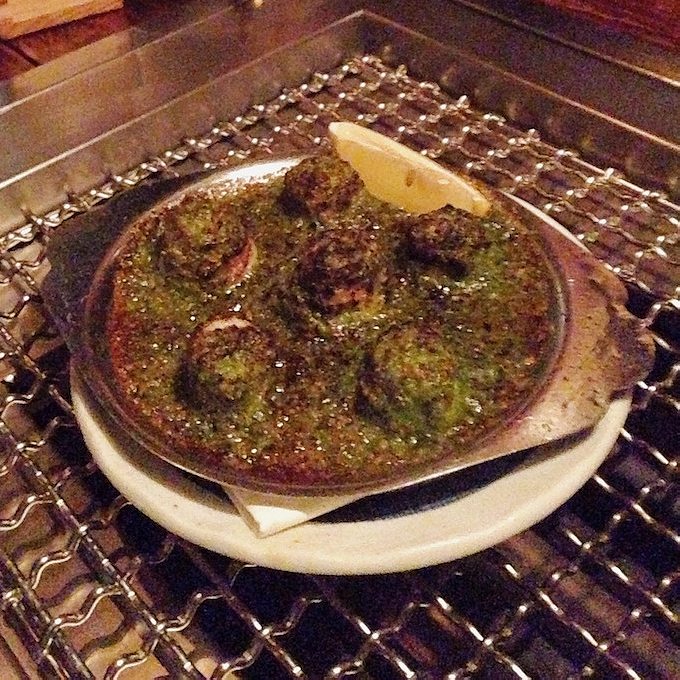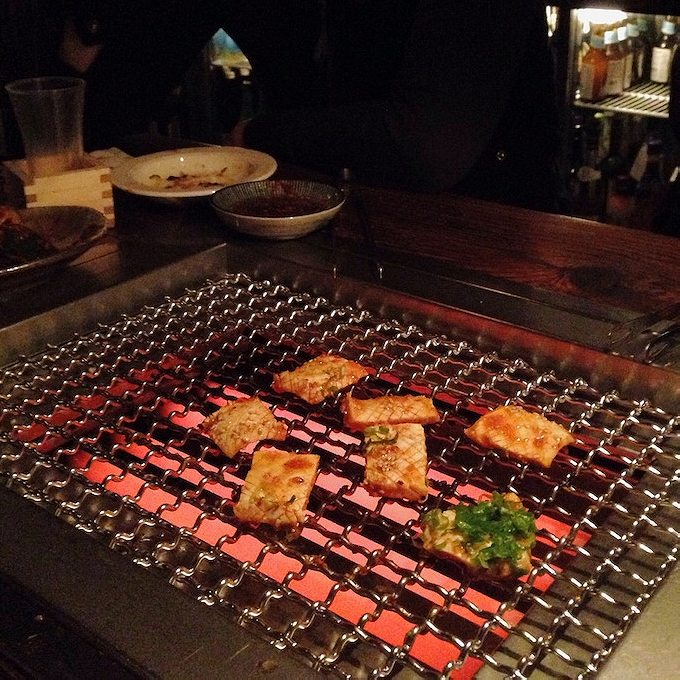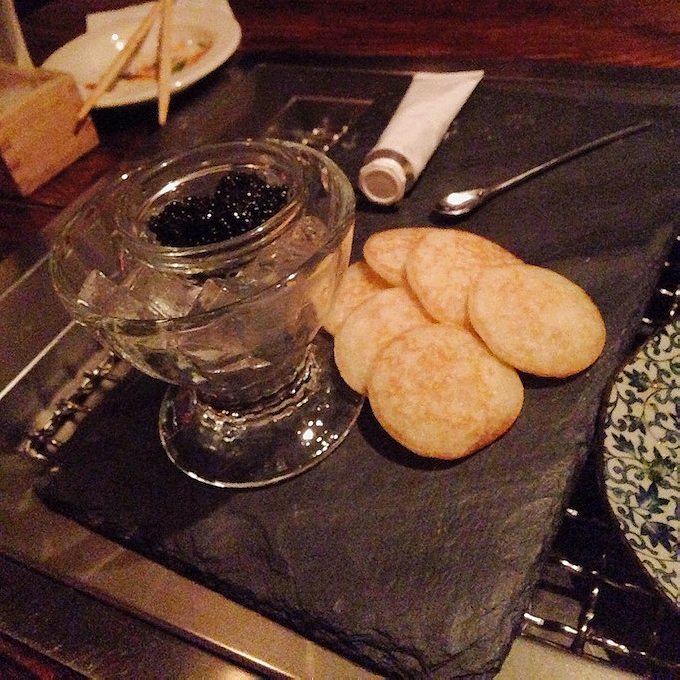At Takashi in the West Village, columnist Howard Chua-Eoan shares offal with the men and women of the Organ Meat Society.
Cocktails & Carnage is a weekly interview column from former TIME News Director Howard Chua-Eoan. Every Thursday. Read previous columns here.
“A penis isn’t a substantial piece of flesh,” came the opinion from across the table at Takashi on Hudson Street. “To manage an erection it needs a lot of hydraulics.” These are the kinds of conversations that one finds at the Organ Meat Society. It’s a small, informal group of New Yorkers with one common obsession: the never-ending search for obscure offal.
Robert Sietsema, formerly the restaurant reviewer of the Village Voice and now with Eater New York, founded the Society 16 years ago. The idea, he explained once, came from his work on the crime beat for a local paper, which gave him intimate knowledge of the many ethnic neighborhoods of New York—and where to eat while on assignment there. The specialty in many of them was organ meat. So he gathered innard-loving friends, including Dan Okrent, until recently an Editor-at-Large for TIME Inc. but more famously the inventor of Rotisserie Baseball, and the Organ Meat Society was born.

But Takashi, tonight’s restaurant, was different. Unlike the ethnic restaurants largely in Brooklyn and Queens that seem to predominate on the Society calendar, Takashi is a thoroughly upscale Village eatery.
The prices on the menu gave us pause. The Society’s rule is that dinner should not cost more than $120 a person. But we got good advice from the waiter. And we also decided not to order bottles of cold sake, which would have upped the final tab. At the end, it was $95 per person. A little steep for those of us who were getting used to $25 to $30 a head at Chinese offal feasts. Nevertheless, Takashi put on quite the show.
The restaurant has been around for more than three years and has a single star from the New York Times. It is small and can feel a little cramped. Yet, the look is appealing: Dune (à la David Lynch) meets a Korean grill, framed in a wood-grain Japanese esthetic (Chef Takashi was born in Osaka to a family of Korean heritage). The smoke from each table’s small yakiniku/bulgogi grill is piped away by way of what at first look like super-trendy tubular light fixtures but are really extendable black exhaust pipes.

The 10 people at the table were here for offal. There was only one small disagreement over exactly which innard to order, between the two members who had been to Takashi before. Melissa Easton, industrial designer by profession and the Society’s logistician by avocation, said the raw liver was excellent. But Sietsema thought it was too raw for his liking. So we tabled the namagimo—though Melissa has convinced me to return to try it.
A COW HAS FOUR STOMACHS AND WE GOT TO TRY THREE OF THEM THAT NIGHT
A pleasant trio of starters (kimchi, bean sprouts and a salad of chunky cabbage leaves) was quickly followed by a spectacular tartare, strips of meat melded together with a raw quail egg and a generous spritz of lemon. The timing of the presentations were as precise as cues for a Broadway show. As soon as we were done with the tartare, the staff brought out uni layered on shizo leaf and wagyu beef over a thin strip of dried seaweed. We were told to ingest the generous servings—looking like little rectangular amulets—in a single bite. That proved to be a deliciously easy task, all the ornateness melting away with the fragile nori that served as the wrap for the sea urchin and beef.

A cow has four stomachs and we got to try three of them that night. I was a little confused but I think the first stomach we received was actually the third, served in little strips with a spicy sauce on the side. As someone at the table said, “It’s like the best rubber chicken you’ve ever had.” We would eventually get the first and second stomachs as well on the grill. If you want to get technical, the first stomach is called the rumen, the second the reticulum (recognizable because of its honeycomb texture on one side); the third is omasum; and the fourth the abomasum. I don’t think we got the abomasum.
We did, however, receive three other intriguing dishes. First was what the restaurant rather bluntly called Testicargot—bull’s testicles prepared escargot style, in a garlicky, pesto-colored sauce. Then there was calf’s brain cream served in what looked like a white unlabeled paint tube. You squeezed it onto perfectly round little blini and topped it off with caviar. Finally, there was aorta or kori kori. It was tough and rigid but tasty—and the closest thing to heart we could get that night since Takashi was all out of that core organ.

All the while, the waiters were giving us very clear instructions about how to eat and prepare our food. The times for grilling each type of meat were prescribed to the half-minute (Melissa kept time): a minute on each side for the liver, 30 seconds each for the beef cheeks, five for the sweetbreads before flipping over for another five. And so on. The results were delicious—including the aorta, even though it gave everyone a little bit of a fight. For those wanting more edification, a colorfully illustrated chalkboard provided more details about the virtues of eating horumon—the Japanese word for offal.
I SUDDENLY FELT A PANG IN MY SINGLE STOMACH. THIS WAS POOR MAN’S FOOD AT RICH MAN’S PRICES
Staring contently at the remnants of our gastronomic evisceration, I suddenly felt a pang in my single stomach. This was poor man’s food at rich man’s prices. And so I felt guilt, perhaps brought on by my recent reporting on the Pope for TIME’s Person of the Year and his exhortations against consumerism. But it was not the Pontiff who came to my mind’s eye but my good friend Dan Mathews. Dan is a vegan and, more importantly, vice-president of PETA. For all his outrageous activism for the group, he is quite happy to share tables with carnivores. It is, he has said, all part of outreach and a search for allies and friends for the cause of ethical treatment of all animals. Not everyone has to be a vegan to be a friend of PETA, he says. The Pope says similar things about the Church.

I now try to eat only pasta with a vegetable based sauce when I have lunch with Dan. Or drink, because, well, wine is fruit juice. I had fish the first time I went out with him years ago. And then he told me how he became a vegan. When he was a teenager, he went on a fishing trip on which his father landed a flounder that flopped helplessly on the deck of the boat. Dan remembers the flat and flabby fish staring at him with its same-sided eyes as his father and brother laughed at its ugliness. And Dan—who was overweight and closeted at the time—said he identified with the fish and could not eat meat or fish or fowl from then own. As he spoke, I stared at my trout.
At Takashi, with my belly full of the belly and testicles of cattle, I began to think that I might have to have a vegan feast soon. If only to sustain the livestock that is now part of my soul.